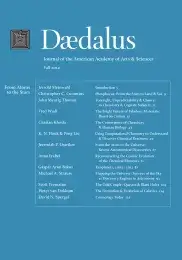On Beckett’s “neither” & Giacometti’s Figurine entre deux boîtes qui sont des maisons
I am very grateful to the editors of Dædalus for permitting and even encouraging me to select two works–Samuel Beckett’s “neither” and Alberto Giacometti’s sculpture Figurine entre deux boîtes qui sont des maisons–for my discussion of influence. As I have been associated with literature departments throughout my career, I have chosen Beckett’s for my primary text. But while I believe that what I want to say could be said from that work alone, I also believe that it will be more forceful, more convincing, and surely more graphic if I couple “neither” with Giacometti’s Figurine. And as artists, Beckett and Giacometti had, in the final analysis, so much in common that when we read, as a summary judgment of a whole body of work, that “he is one of the few artists who has contributed fundamentally to the way the human condition is perceived,” no one unfamiliar with the statement could say with any assurance which artist is its subject.
Had I been asked earlier in my career to consider texts that have influenced me and my own work, I would certainly have chosen differently. Indeed, looking through the index to my first book on what might best be called “life-writing,” Metaphors of Self, I find no mention of Samuel Beckett. Yet today there seems to me an inevitability about the choice of Beckett, the only issue being which text to choose from the many that offer themselves. A major reason for this development is that Metaphors of Self, as its title implies, was a nonlinear exercise, a study of various writers in various times, and what each had to . . .
